"Time of observation, 8 AM; 'height' of barometer, 29.72 inches; 'height' of attached thermometer, 52F; reduced barometer (sea level), 29.655 inches; temperature (outdoor), 44F; temperature of the wet bulb, 38F; direction of wind, west; velocity of wind, 3 mph; pressure of wind (1 lbs. per square foot), .044; amount of cloud, 1/4."
The foregoing is a transcript of the first official Weather Bureau observation taken in Boston. The place was the Old State House on the corner of State and Devonshire Street's. The date was Tuesday, November 1, 1870. The identity of observer is uncertain, but he was one of three: Sergeant S.E. Cole, Pvt. Black, or Pvt. Huneke, all of the Signal Service of the U.S. Army.
The following is a historical perspective of weather observations maintained, including the evolution of collocated weather forecast operations, from the earliest infancy of American history to the present day National Weather Service. From the first observers, to the present staff of the National Weather Service of Boston, the series of tabs presented are broken down into a series of years that mark significant milestones in history concerning weather operations and forecast operations for the Southern New England region.
Pre-Weather Bureau observations in America go back into early colonial times. The first known continuous weather log was maintained in 1644-45 by the Reverend John Campanius at Swedes Fort, near Wilmington, Delaware. Among the Boston's notable early records are those of Paul Bradley, Chief Justice of Massachusetts, who kept records from 1738-50 in Boston, and those of John Winthrop, Harvard College Professor, covering 1742-78. One famous American interested in weather was Henry Thoreau who commented upon the trends of Indian summer for the falls of 1851-60 at Concord, MA.
Most early records were private undertakings, not coordinated by any central organization. But the importance of simultaneous observations at many places was recognized by Thomas Jefferson before the Revolutionary War. In fact, Jefferson became nearly a private unofficial weather bureau, collecting records from such distant points as Quebec and from as far west as the Mississippi River.
Perhaps the first observations made in early America as a part of an organized effort were sponsored by the Meteorological Society of the Palatinate (Germany). This organization in 1780 issued rain gages to fourteen German stations, several others in Europe, and to Cambridge, MA. Detailed publications of the data were issued until 1792, when the French Revolution interfered.
The first federal government sponsored weather service in America resulted from a directive during the War of 1812, by Dr. James Tilton, Surgeon General of the Army, that hospital surgeons take observations and keep climatological records. This project grew slowly, but included 97 army camps by 1853.
The advent of the telegraph brought the possibility of a new use for weather observations during the 1840's, that of weather forecasting. One of the earliest supporters in this cause was Prof. Joseph Henry, who became secretary of the new Smithsonian Institution. This organization organized a network of observatories, and in 1849 Prof. Henry received his first observations via telegraph, the same year that the British inaugurated a similar service. Within the year Prof. Henry had a network of 150 stations. The first synoptic weather map, containing current information from the station network, was displayed by Prof. Henry in 1849. This could be called the early beginning of weather forecasting service in the United States.
By act of Congress on February 9, 1870, the Secretary of War was authorized and required, "... to provide for taking meteorological observations at the military stations in the interior of the continent and at other points in the States and Territories of the United States, and for giving notice on the northern lakes and on the seacoast, by magnetic telegraph and marine signals, of the approach and force of storms."
The duty of executing this resolution was assigned to Gen. A.J. Myer, Chief, Signal Officer, U.S.A. His first step was the establishment of a school of instruction in meteorology at Fort Whipple (now Fort Myer), Virginia. Thus began regularly published weather predictions began on February 19, 1871. They were called "probabilities" and were made three times daily for such elements and periods in advance as seemed warranted by the maps, and for 8 geographical districts:
- New England
- Middle States
- South Atlantic States
- Lower Lakes
- Upper Lakes
- Eastern Gulf
- Western Gulf
- Northwest
The term "indications" was substituted for "probabilities" on December 1, 1876, and this was changed to "forecasts" on April 1, 1889.
The Boston Weather Bureau office, originally where the first observation was taken on November 1, 1870 at the Old State House on the corner of State and Devonshire Street's, was moved to 103 Court Street, Room No.10 on Jan. 10, 1871. Thereafter it was moved to the Equitable Building, on the corner Milk and Devonshire Streets, Room No.65, on Aug.12, 1875, where it remained until it was moved again in 1884 to the Old U.S. Post Office and Courthouse.
On October 1, 1884, the Boston Office of the Weather Bureau was relocated to the Old U.S. Post Office and Courthouse, where it was to remain for 45 years until 1929.
During this time, the Blue Hill Observatory on top of Big Blue in Milton would begin a weather and climatic observational program in 1885. And by October 1, 1890, the act of transferring the meteorological work of the Signal Service to the Weather Bureau was accomplished. This act became effective on July 1, 1891.
At that point, the complement of the Boston Office included:
- Local Forecast Officer (in Charge): J. Warren Smith
- Observer: Park Merrill
- Observer: T.L. Bridges
- Observer: J.W. Cronk
- Observer: C.J. Doherty
- Observer: F.A. Davis
- Observer: E. Douglas
- Observer: J.P. Cowles, Jr.
- Messenger: G. B. Ackerman
- Cleaner: Kate E. Reynolds
In October 1891, the renowned meteorologist, H.H. Clayton, joined the force, replacing Observer C.J. Doherty. Theodore L. Bridges would serve for 42 years, from September 1889 until 1931. Mark T. Nesmith would begin his service with the Weather Bureau on February 12, 1902, until his retirement in June, 1952, a period of more than 50 years.
Per the
Daily Journal of Thursday, Aug. 25, 1887, J. Warren Smith became the first civilian Officer in Charge of the Boston Office of the Weather Bureau. He served in that capacity until June 14, 1924, compiling a total of 37 years of weather service in Boston. He was replaced by George A. Loveland.
Meanwhile, the observation station at Logan Airport was established on October 15, 1926. Pilot balloon observations, only, were taken for about a year, after which additional elements of synoptic observations were included. Weather briefing service to pilots began on Nov. 1, 1927.
The Airport Observation Station was quartered at U.S. Army Hangar No.1 until April 1, 1927, then, temporarily located on the 8th floor of the Army Base in South Boston for 7 months. From Nov. 1, 1927, until July 1, 1929, the Army "shacks" served as the Observation Station at the Airport.
With J. Warren Smith's departure on June 14th, 1924, George A. Loveland became the Officer in Charge for the Boston Office of the Weather Bureau, and remained so until August 1933.
The Boston Office of the Weather Bureau would remain at the Old U.S. Post Office and Courthouse until the building was razed to make way for the new Post Office and Courthouse. During that time, Young's Hotel served as interim quarters for the Boston Office of the Weather Bureau from June 7, 1929 to September 29, 1933.
It is unclear as to whether the Boston Office of the Weather Bureau was re-established in the new Post Office and Courthouse, or moved to Logan Field. What is known is that on January 1, 1936, official synoptic and climatic observations for Boston were shifted to the Airport Observation Station at Logan from the Boston Office of the Weather Bureau. With the gradual increase in air traffic volume, the frequency of observations increased to the present rate of 2 or more per hour.
It was during this period that George A. Loveland stepped down as the Officer in Charge for the Boston Office of the Weather Bureau, replaced by G. Harold Noyes who remained in the position until June 1945. On Oct. 1, 1940, during this timeframe and slightly more than 2 years after the disastrous and tragic hurricane of September 21, 1938, the Forecast Center was established, and by July 1945.
G. Harold Noyes was replaced by Clayton Van Thullenar, who remained as Officer in Charge until Dec. 31, 1947. In July 1945, during this time, supervision of all Boston observing installations was transferred to the Forecast Center.
Clayton Van Thullenar was then followed by Paul H. Kutschenreuter who remained as Officer in Charge until Sept. 1, 1950.
The Boston Office of the Weather Bureau was growing throughout the 1940's, and would continue growing into the 1950's. Local divisions of the Weather Bureau included the Forecast Center, the Office of the State Climatologist, the Atlantic Weather Project, and the Blue Hill Observatory Office. In addition there was the establishment of the Forecast Office at Logan Airport which, in addition to general public forecasts, made detailed terminal aviation forecasts, while conducting research to improve forecasts and services. From the Forecast Center there was the Agricultural and Fruit-Frost service which included a special cranberry forecast program. Also fire-weather forecasts aiding local, state, and federal efforts to minimize forest fire losses.
Meanwhile, weekly weather summaries of special interest to agriculture were being issued by the U.S. Dept. of Agriculture. The Atlantic Weather Project supervised and furnished observers for the several weather ships stationed at strategic points in the Atlantic and were later replaced by moored buoys. Weather observations became essential to furnishing forecasts and warnings, particularly for transatlantic air and surface commerce.
Paul H. Kutschenreuter was replaced by Dr. Oscar Tenenbaum, who was given the new title of Meteorologist in Charge. On November 22, 1951, the Boston Office of the Weather Bureau was relocated to the Toutwell Building (Gate No.11).
On December 5, 1963, the station was moved to the General Aviation Administration Building on Maverick Street. It was shortly thereafter that on July 13, 1965, the Weather Bureau became part of the Environmental Science Services Administration (ESSA). The first Administrator of ESSA was Dr. Robert M. White, a native of Boston and a product of Harvard and M.I.T.
By the early 1970's, the United States Weather Bureau became the National Weather Service under the National Oceanic and Atmospheric Administration. The Boston Forecast office at that time was located in the General Aviation Building (the Edson Building) on what is now Harborside Drive.
- Meteorologist-in-Charge, Oscar Tenenbaum
- Principal Assistant (Deputy Meteorologist-in-Charge), Charley Pierce
- Supervisory Aviation Forecaster, Lou Goldman
- Marine Focal Point, Robert Lynde
- Fire Weather Focal Point, Monte Glovinsky
- Lead Forecaster, Albert Flahive
- Lead Forecaster, Howard Rexroad
- Observing Unit Program Leader, Jim Perry
In 1972, the reigns were changed as Anthony Tancreto took over as Meteorologist-in-Charge, with Rodney Winslow as Principal Assistant. Shortly thereafter Rodney Winslow became the Meteorologist-in-Charge, allowing Thomas McGuire to become Deputy Meteorologist-in-Charge. It would be years later that Thomas McGuire would become Meteorologist-in-Charge upon Rodney Winslow's retirement.
By July 1987, the National Weather Service Forecast Office of Boston was moved one block down on Harborside Drive, and located to the first floor of the Massachusetts Technology Center. Two years later in the fall of 1989, Thomas McGuire retired. Shortly thereafter Robert Thompson became the Meteorologist-in-Charge.
The Boston Weather Bureau -- now called the National Weather Service and located at Taunton -- has indeed changed dramatically since its beginnings. However, two things have not altered over the years:
- The changeability and extreme diversity of New England weather and ...
- The dedication of the men and women of the National Weather Service
On November 8, 1993, forecast operations for the National Weather Service Forecast Office of Boston were moved to a new facility in Taunton at the Myles Standish Industrial Park at 445 Myles Standish Boulevard.
The 1990s saw the implementation of a new Doppler radar, automated service observing systems, and major advances in computer technology. Upper air observations remained at Chatham, MA but conducted by contractors rather than NWS personnel.
On March 22nd, 2018, the Boston, MA National Weather Service Forecast Office moved into a new facility in Norton, MA located at the Norton Commerce Center at 46 Commerce Way. Continually co-located with the Northeast River Forecast Center, the office provides a full slate of public, aviation, marine, and hydrologic warning and forecast services for most of southern New England and the adjacent ocean areas, with continued forecast support for fire weather and agricultural weather services, and broadcasting. In addition, from the Norton location, NOAA Weather Radio broadcasts continuously over several transmitters located throughout southern New England.
On April 30th, 2018, Robert Thompson retired after 45 years of federal service, serving 29 years as Meteorologist in Charge for the Boston, MA National Weather Service Forecast Office. Not long after, on October 1st, 2018 Andy Nash became the Meteorologist in Charge.
A staff of skilled electronic technicians maintain the complete systems at Norton and surrounding locations. And personnel at the National Weather Service's Blue Hill Observatory, with records dating back to 1885, continue to take climatological observations.
The National Weather Service continues to expand its outreach to the broader public, relying upon hundreds of volunteers who supplement weather and climate information throughout Southern New England. Over 1,500 storm spotters provide timely "ground truth" information to forecasters during severe storms. And over 100 cooperatives take daily measurements of temperature and precipitation to preserve the New England climate record.
| Office Administration |
|
Lead Meteorologists |
| Meteorologist in Charge: |
Andy Nash |
Matthew Belk |
| Warning Coordination Meteorologist: |
Frank Nocera |
Kevin Cadima |
| Science Operations Officer: |
Joseph Dellicarpini |
Hayden Frank |
| Electronic Systems Analyst: |
Mark Boucher |
Andrew Loconto |
| Information Technology Officer: |
Vacant |
Bryce Williams |
| Observation Program Leader: |
Vacant |
Vacant (1) |
| Senior Service Hydrologist: |
Rob Megnia |
|
| Administrative Support Assistant: |
Christine Griffith |
|
| Electronic Technicians |
|
Meteorologists |
| Matt Desilets |
|
|
| Hans Hanner |
|
Candice Hrencecin |
| Sandra White |
|
Caity Mensch |
| Josue Diaz |
|
Kyle Pederson |
| Vacant (1) |
|
Emily McMinn |
| |
|
Francis Tarasiewicz |
| |
|
Vacant (1) |
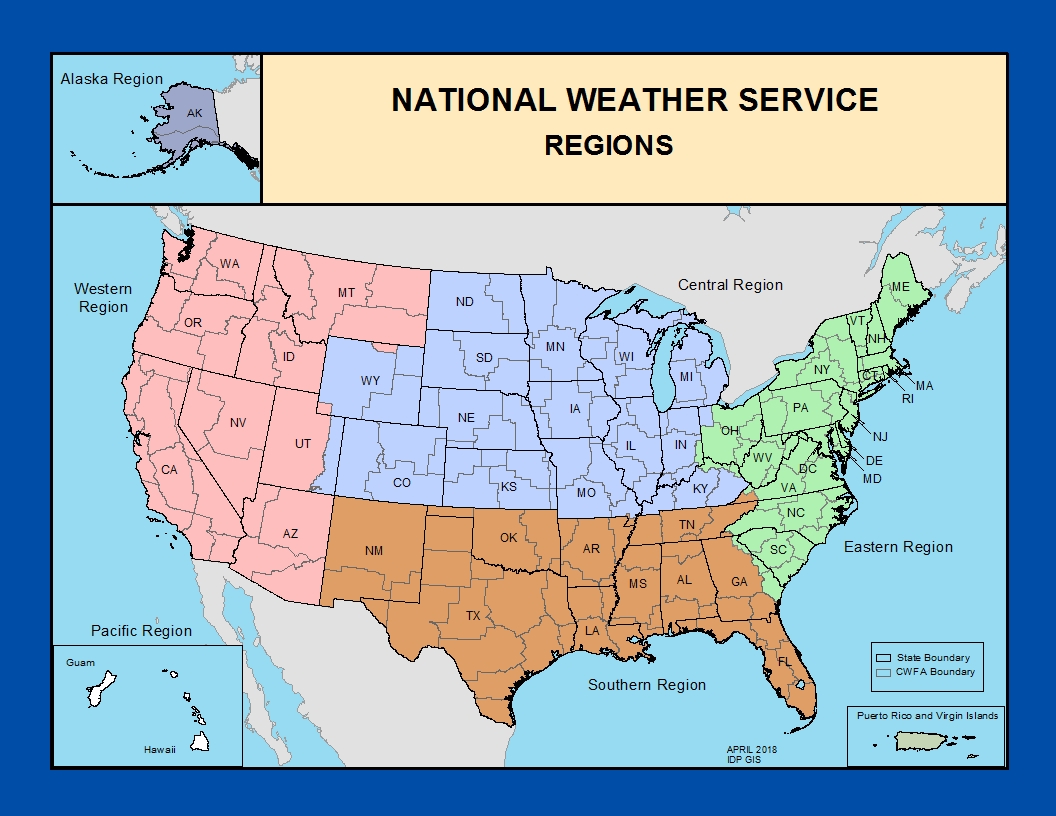

| NWS Regions |
NWS County Warning Areas
Southern New England |
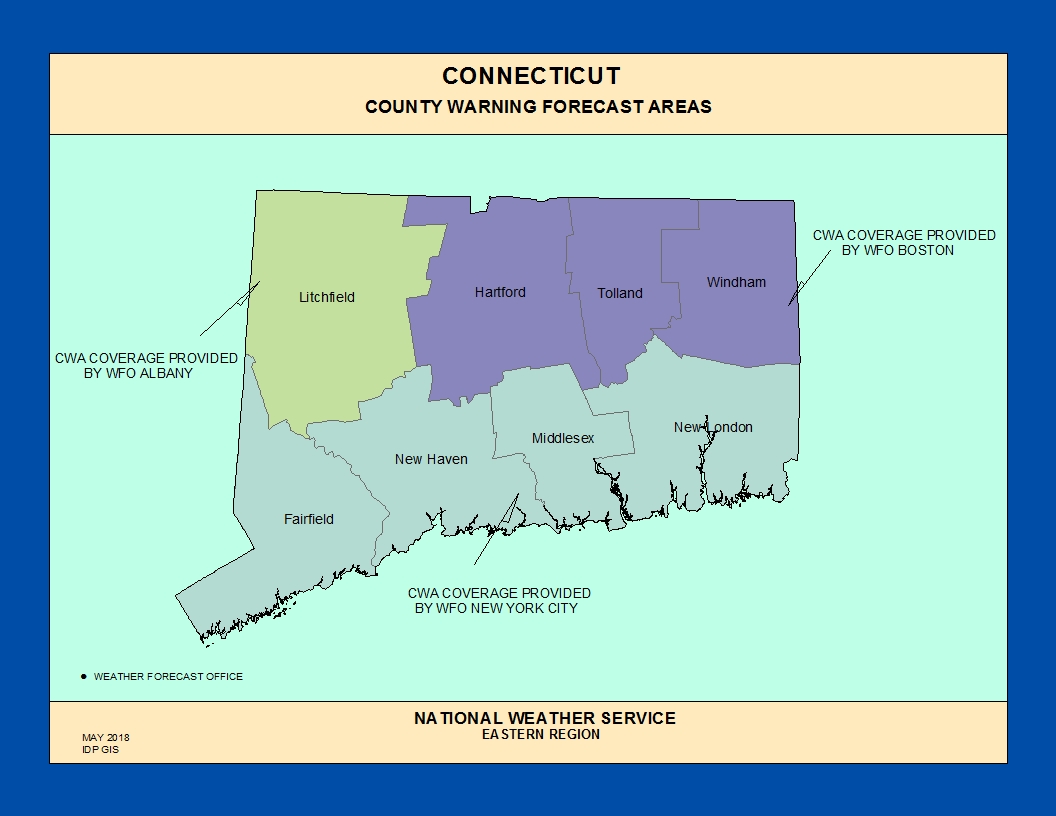

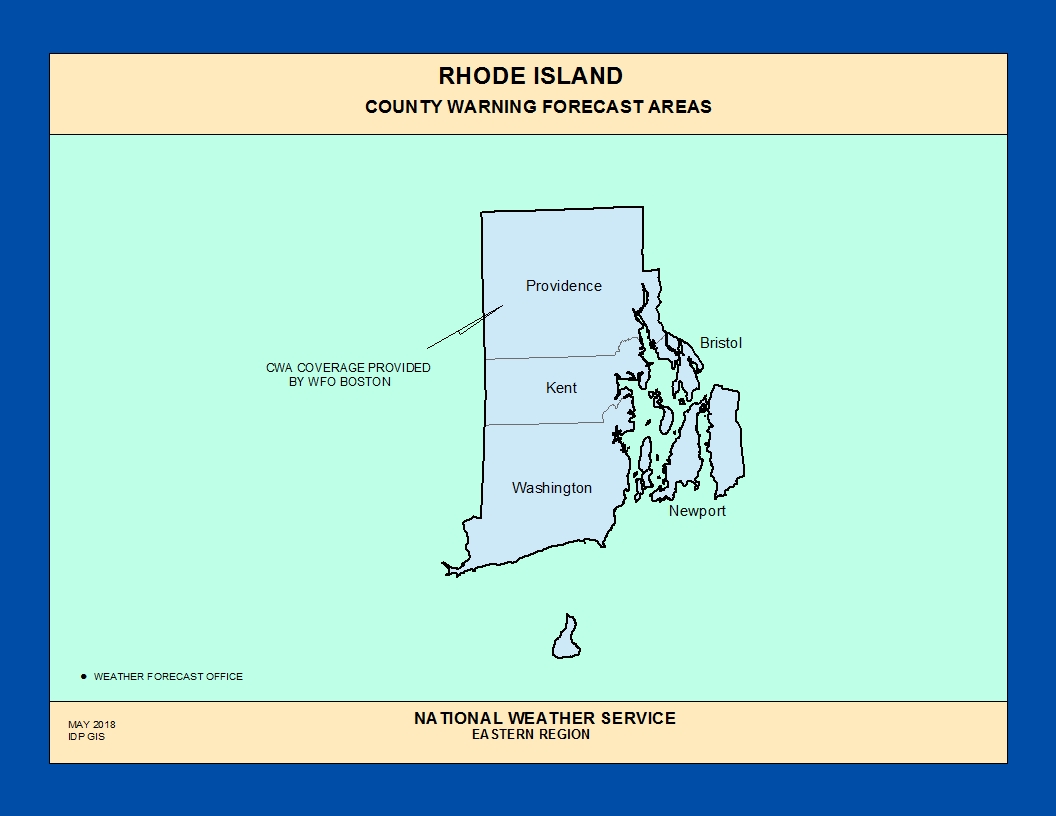
Connecticut
County Warning Forecast Areas |
Massachusetts
County Warning Forecast Areas |
Rhode Island
County Warning Forecast Areas |
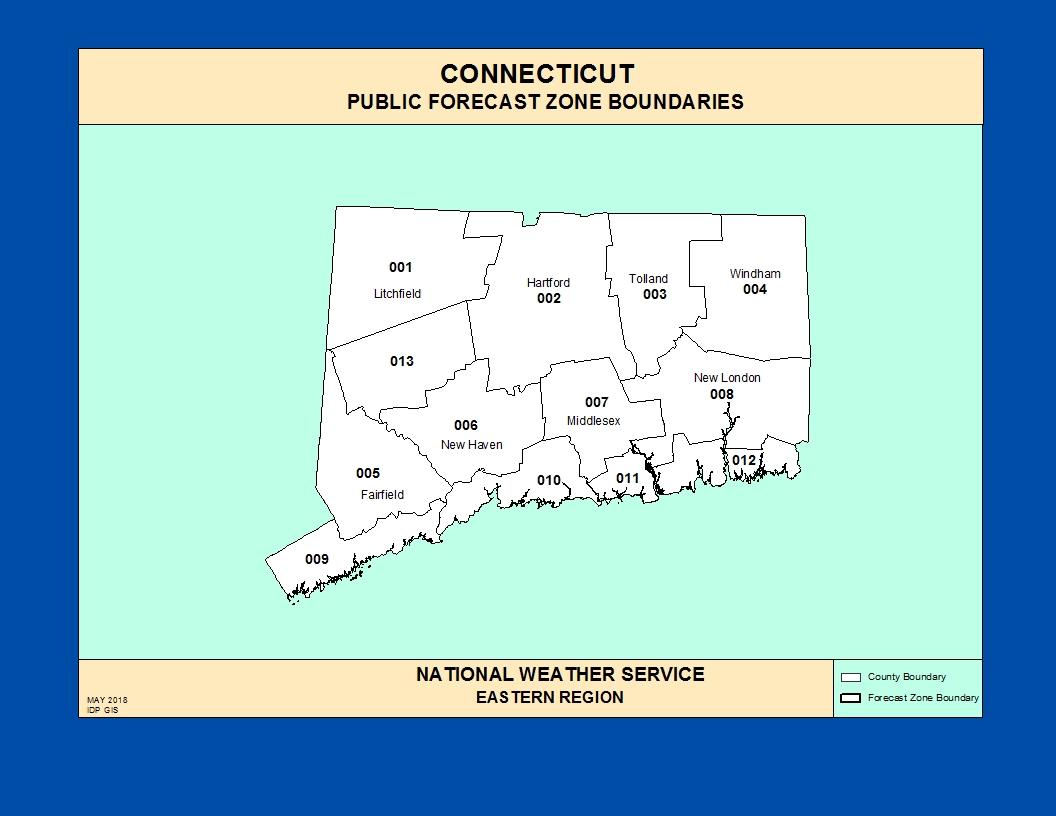
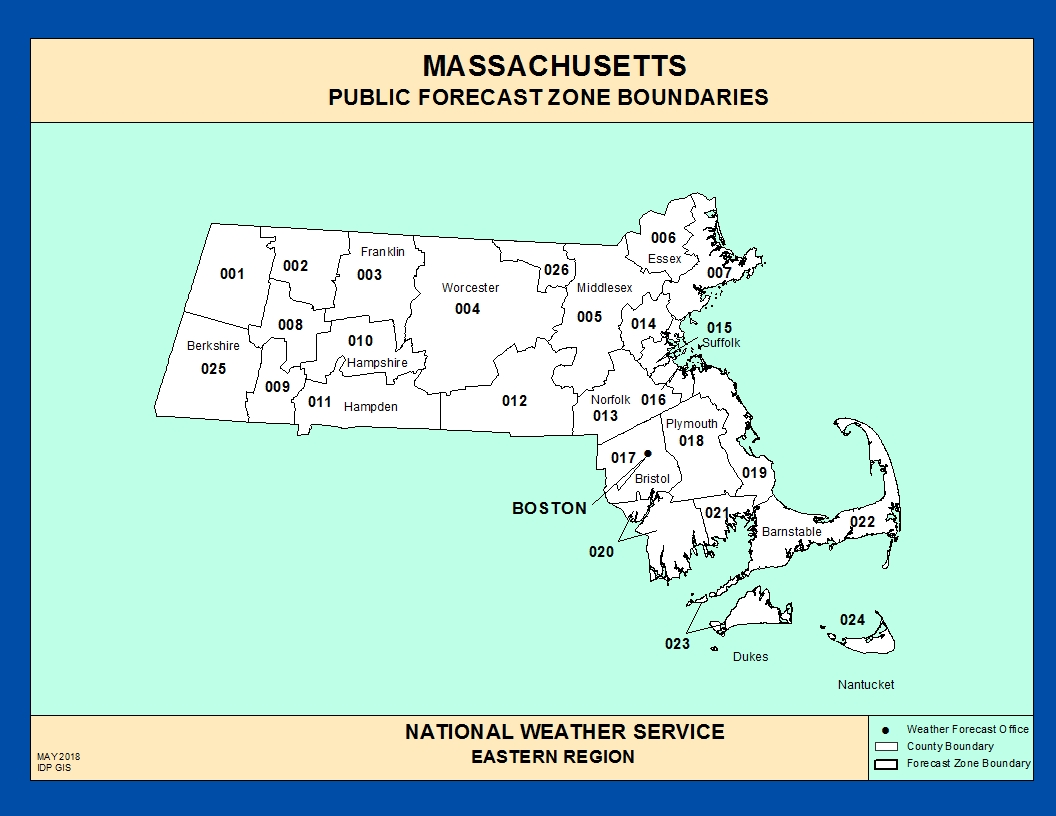

Connecticut
County Public Forecast Zones |
Massachusetts
County Public Forecast Zones |
Rhode Island
County Public Forecast Zones |







